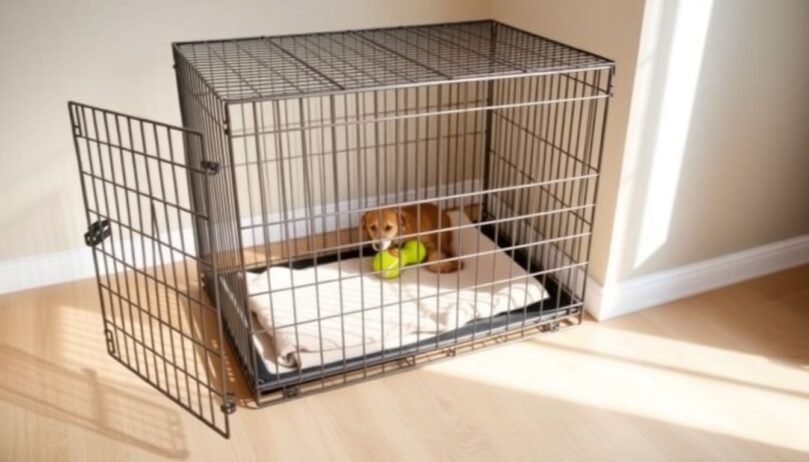The Benefits of Using a Dog Crate for Training
- 24 January 2025
- BuyAPet Editorial Team
- All Dogs
Dog Crate Training: Benefits for a Well-Behaved Pup 🐶
A thoughtfully used crate is a cosy den, a powerful training tool, and a safety zone—not a punishment.
Unlocking the potential of a dog crate can transform your training experience. Many people see crates as cages, but used correctly, they offer comfort, structure, and safety. Understanding the benefits creates better behaviour and a secure retreat for your dog.
The Crate’s Untapped Potential: More Than Just a Cage 🧰
Why It Helps
- Provides a secure haven for rest and decompression.
- Speeds up house training with predictable routines.
- Prevents risky or destructive behaviour during downtime.
Mindset Shift
When you make the crate inviting and predictable, your dog learns it’s a personal den—safe, quiet, and positive.
Addressing Common Crate Training Myths 🧠
“Crates are Cruel”
Used kindly and for reasonable durations, crates reduce stress and keep dogs safe. They’re not a punishment zone.
“Dogs Hate Them”
With gradual introduction, most dogs relax and even choose the crate for naps.
“It Hurts the Bond”
Consistency, rewards, and clear routines actually strengthen trust and communication.
Setting the Stage for Success: Preparing for Crate Training 🧩
Pick the Right Crate
- Size: Your dog can stand up, turn around, and lie flat comfortably.
- Type: Wire (airflow/visibility), plastic (cozier), or soft (for calm, crate-trained dogs).
- Mat/bedding: Comfy but safe; avoid loose stuffing for heavy chewers.
Prime the Environment
- Place in a lived-in area (not isolation).
- Cover one side for den-like feel if it calms your dog.
- Add a safe chew or food puzzle for positive associations.
Warm-Up Plan (3 Easy Steps)
- Explore: Door open; toss treats/toys inside. Reward any curiosity.
- Settle: Feed meals just inside; then inside with the door still open.
- Door practice: Brief closes (5–30 sec), open before fussing; repeat and extend gradually.
Safety & Security: A Sanctuary for Your Canine Companion 🛡️
Accident & Hazard Prevention
- Protects from chewing wires, ingesting hazards, or door-dashing.
- Creates a controlled rest space during busy times.
Calm & Relaxation
Many dogs settle faster in a predictable den. Use white noise or a cover if it soothes (and your dog tolerates it).
Essential Safety Rules
- Remove collars/tags in-wire crates to avoid snagging.
- Provide water for longer rests (no-spill bowl or bottle).
- Never use the crate for punishment; keep it neutral/positive.
House Training Success: Mastering Potty Breaks 🚽
Set a Consistent Schedule
- First thing in the morning & last thing at night.
- After meals, naps, and play sessions.
- Regular intervals matched to age and bladder capacity.
Overnights & Naps
The cosy, right-sized space encourages holding it until the next planned break. Keep night trips calm and low-key.
Reward Outside
Mark success with a cue (“Yes!”) and reward immediately after toileting outdoors to build the habit.
Curbing Undesirable Behaviours 🎯
Barking & Whining
Teach quiet by rewarding calm. Avoid letting your dog out during a tantrum—wait for a brief pause.
Chewing & Digging
Offer safe chews/enrichment in the crate to occupy the mouth and brain when you can’t supervise.
Separation Practice
Use short absences and gradual build-ups. Pair with a stuffed Kong or lick mat to create a positive association.
Building Confidence & Independence 🌱
Security & Ownership
When the crate predicts comfort and rewards, dogs choose it for breaks and naps—true independence.
Better Sleep
Consistent crate routines support restful sleep and smoother days.
Self-Soothing
Calming chews, predictable cues, and cosy bedding help anxious dogs down-shift.
Enhanced Bond & Communication 🤝
Positive Associations
Reward voluntary entries; toss treats in randomly; feed meals in the crate so it stays a “good place.”
Safe Space During Stress
Fireworks, storms, parties—teach “go to bed” so your dog has a calm retreat on cue.
Clear Communication
Routines around rest, potty, and play make needs predictable and reduce frustration on both sides.
FAQs & Pro Tips 📝
How long can my dog stay crated?
Use the crate for reasonable rest periods, not all day. Puppies need very frequent breaks. Adult dogs should have ample daily exercise, training, and enrichment outside the crate.
What if my dog cries in the crate?
Go back a step: shorter sessions, higher-value chews, and reward calm. Open the door after a moment of quiet—not mid-whine—so calm is what pays.
Travel & vet visits?
Crate-comfort makes car travel and clinic stays safer and less stressful. Secure travel crates; never leave dogs in hot cars.
Signs the crate plan isn’t working
Persistent panic, soiling, or injury attempts signal that you should pause and seek guidance from your vet or a qualified behaviour professional.
Try this today: Toss 10 treats into the open crate across the day. Tonight, feed dinner inside with the door open. Tomorrow, close it for 10–30 seconds while calmly chewing.
Set Up Your CrateThis article offers general information and isn’t a substitute for personalised veterinary or training advice.
